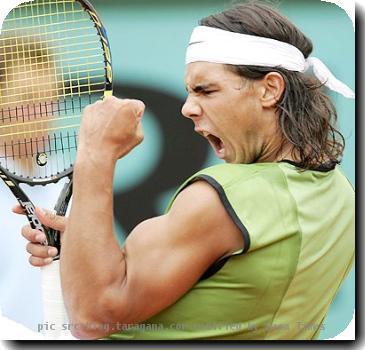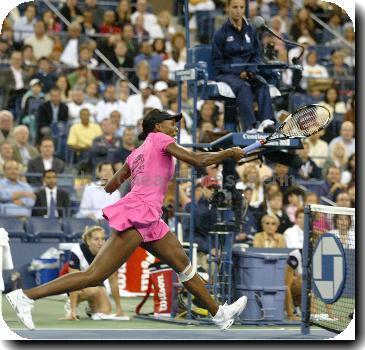Age, rankings ‘just a number’ for American players at US Open
By Eddie Pells, APMonday, September 6, 2010
Williams, Querrey play the US Open numbers game
NEW YORK — Venus Williams says 30 is the new 20. Sam Querrey likes to think 20 could be No. 1.
Thirty-year-old Williams is talking about age, and No. 20 Querrey is talking about seeding, but both are talking about the same thing when it comes to the U.S. Open.
They’d like to be the ones to put America back on top at its own national championship.
“The average sports fan basically watches the Grand Slams,” Querrey said after his third-round win over No. 14 Nicolas Almagro on Sunday. “If you don’t have a guy in the finals or winning one of those, in tennis, you really don’t get a lot of recognition.”
Querrey and 19th-seeded Mardy Fish, who plays No. 3 Novak Djokovic on Monday, are still long shots — but the only two remaining hopes for the United States to break a seven-year drought without a men’s champion.
Another candidate, No. 18 John Isner, lost 6-4, 6-7 (7), 7-6 (5), 6-4 Sunday night despite hitting 33 aces against No. 12 Mikhail Youzhny of Russia.
“I’m really sorry, but you still have a lot of USA players,” Youzhny told the crowd at Arthur Ashe Stadium, which was squarely in Isner’s corner.
In Monday’s first match in Ashe Stadium, Dominika Cibulkova upset No. 11 Svetlana Kuznetsova 7-5, 7-6 (4) to advance to the quarterfinals. The match started less than 10 hours after the end of No. 5 Sam Stosur’s 6-3, 2-6, 7-6 (2) win over No. 12 Elena Dementieva — a contest that ended at 1:35 a.m. Monday, the latest finish for a women’s match in U.S. Open history.
Next up for Stosur is a match against No. 2 Kim Clijsters, who wrapped up her 6-2, 6-1 win over Ana Ivanovic shortly after the lunch hour Sunday.
“She’s got a 14-hour head start on me,” Stosur said. “She played first and I played last, so there’s not much bigger difference than that.”
Williams, meanwhile, is a two-time U.S. Open champion and the only American left in the women’s draw. She defeated No. 16 Shahar Peer 7-6 (3), 6-3. With a quarterfinal matchup looming against another 30-year-old player, Francesca Schiavone, Venus found herself fielding questions about how “old” is too old in women’s tennis.
“Seems like everybody is hitting their stride at 30. It’s the new 20,” Williams joked. “But I’m hoping that my experience will help me, just like it did today.”
Practically everything about Williams’ win over Peer spoke of a player with years of experience in pulling things together when she’s not at her best.
On a windy, tougher-than-expected day against an opponent she’s now played six times without dropping a set, Williams got only 48 percent of her first serves in. She faced six break points and lost three. She squandered five chances to wrap up the first set in a 22-point 12th game.
She looked to still be rounding into form after missing most of August with an injury to her left kneecap.
“It’s always good to have a tough match, I think, or a tougher match,” Williams said. “The kind of a match where you have to challenge yourself against your opponent and the conditions and everything and just continue to stay tough and to stay positive.”
Querrey’s next match will come against No. 25 Stanislas Wawrinka, who pulled off a 6-7 (3), 7-6 (4), 6-3, 6-3 upset against No. 4 Andy Murray of Britain. Murray knows all about what it’s like to play for a country that desperately wants a winner. No British man has won a Grand Slam tournament since 1936. This was Murray’s second straight early exit from the U.S. Open, and his latest loss will surely get picked apart back home.
“I have no idea of whether I’ll win a Grand Slam or not,” Murray said. “I want to. But if I never win one, then what? If I give 100 percent, try my best, physically work as hard as I can, practice as much as I can, then that’s all I can do.”
Same goes for Querrey.
With Isner gone (He played 22 fewer games in the entire tournament than he did in his historic 70-68 fifth set at Wimbledon) and No. 9 Andy Roddick eliminated earlier in the week, Querrey and Fish will help shape opinion on whether the arrow is pointing up or down at the highest reaches of American tennis.
They still have time to be remembered as role models for a new generation of American stars. Or they could continue a trend that began this summer when Roddick briefly dropped to No. 11 and, for the first time since the rankings began in 1973, there wasn’t a single American in the top 10.
“I mean, you always hear that,” Querrey said. “It’s kind of like any sport. You’ve got waves where you’ll have a group of Americans in the top 10; you might have a couple years where we don’t. It’s like with the Lakers: They’ll win some championships, and (then) they won’t make the playoffs. It’s just like that.”
These are not the kind of issues they worry about in Spain these days.
Sparked by No. 1 Rafael Nadal’s surge to the top, Spain is turning into a tennis factory of sorts. Nadal, who cruised to a straight-set victory over Gilles Simon, was one of five Spaniards to win third-round matches Sunday. Add No. 21 Albert Montanes, who won Saturday, and the country has six members in the round of 16 — tying the record for any country other than the United States at the U.S. Open.
“It’s always nice to see all the Spanish winning and being in the last rounds, no?” said No. 8 Fernando Verdasco, who eliminated 2002 Wimbledon runner-up David Nalbandian of Argentina 6-2, 3-6, 6-3, 6-2.
Tags: Europe, Events, Men's Tennis, New York, North America, Rafael nadal, Spain, Svetlana kuznetsova, U.s. Open Tennis Championship, United States, Venus williams, Western Europe, Wimbledon Championships, Women's Sports, Women's Tennis



